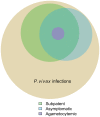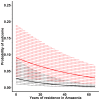Epidemiology of disappearing Plasmodium vivax malaria: a case study in rural Amazonia
- PMID: 25166263
- PMCID: PMC4148206
- DOI: 10.1371/journal.pntd.0003109
Epidemiology of disappearing Plasmodium vivax malaria: a case study in rural Amazonia
Abstract
Background: New frontier settlements across the Amazon Basin pose a major challenge for malaria elimination in Brazil. Here we describe the epidemiology of malaria during the early phases of occupation of farming settlements in Remansinho area, Brazilian Amazonia. We examine the relative contribution of low-density and asymptomatic parasitemias to the overall Plasmodium vivax burden over a period of declining transmission and discuss potential hurdles for malaria elimination in Remansinho and similar settings.
Methods: Eight community-wide cross-sectional surveys, involving 584 subjects, were carried out in Remansinho over 3 years and complemented by active and passive surveillance of febrile illnesses between the surveys. We used quantitative PCR to detect low-density asexual parasitemias and gametocytemias missed by conventional microscopy. Mixed-effects multiple logistic regression models were used to characterize independent risk factors for P. vivax infection and disease.
Principal findings/conclusions: P. vivax prevalence decreased from 23.8% (March-April 2010) to 3.0% (April-May 2013), with no P. falciparum infections diagnosed after March-April 2011. Although migrants from malaria-free areas were at increased risk of malaria, their odds of having P. vivax infection and disease decreased by 2-3% with each year of residence in Amazonia. Several findings indicate that low-density and asymptomatic P. vivax parasitemias may complicate residual malaria elimination in Remansinho: (a) the proportion of subpatent infections (i.e. missed by microscopy) increased from 43.8% to 73.1% as P. vivax transmission declined; (b) most (56.6%) P. vivax infections were asymptomatic and 32.8% of them were both subpatent and asymptomatic; (c) asymptomatic parasite carriers accounted for 54.4% of the total P. vivax biomass in the host population; (d) over 90% subpatent and asymptomatic P. vivax had PCR-detectable gametocytemias; and (e) few (17.0%) asymptomatic and subpatent P. vivax infections that were left untreated progressed to clinical disease over 6 weeks of follow-up and became detectable by routine malaria surveillance.
Conflict of interest statement
The authors have declared that no competing interests exist.
Figures





Similar articles
-
High proportions of asymptomatic and submicroscopic Plasmodium vivax infections in a peri-urban area of low transmission in the Brazilian Amazon.Parasit Vectors. 2018 Mar 20;11(1):194. doi: 10.1186/s13071-018-2787-7. Parasit Vectors. 2018. PMID: 29558985 Free PMC article.
-
Reactive Case Detection for Plasmodium vivax Malaria Elimination in Rural Amazonia.PLoS Negl Trop Dis. 2016 Dec 12;10(12):e0005221. doi: 10.1371/journal.pntd.0005221. eCollection 2016 Dec. PLoS Negl Trop Dis. 2016. PMID: 27941968 Free PMC article.
-
A large proportion of asymptomatic Plasmodium infections with low and sub-microscopic parasite densities in the low transmission setting of Temotu Province, Solomon Islands: challenges for malaria diagnostics in an elimination setting.Malar J. 2010 Sep 7;9:254. doi: 10.1186/1475-2875-9-254. Malar J. 2010. PMID: 20822506 Free PMC article.
-
Should we care about Plasmodium vivax and HIV co-infection? A systematic review and a cases series from the Brazilian Amazon.Malar J. 2021 Jan 6;20(1):13. doi: 10.1186/s12936-020-03518-9. Malar J. 2021. PMID: 33407474 Free PMC article.
-
Global Epidemiology of Plasmodium vivax.Am J Trop Med Hyg. 2016 Dec 28;95(6 Suppl):15-34. doi: 10.4269/ajtmh.16-0141. Epub 2016 Jul 11. Am J Trop Med Hyg. 2016. PMID: 27402513 Free PMC article. Review.
Cited by
-
Genome-wide diversity and differentiation in New World populations of the human malaria parasite Plasmodium vivax.PLoS Negl Trop Dis. 2017 Jul 31;11(7):e0005824. doi: 10.1371/journal.pntd.0005824. eCollection 2017 Jul. PLoS Negl Trop Dis. 2017. PMID: 28759591 Free PMC article.
-
Submicroscopic and Asymptomatic Plasmodium Parasitaemia Associated with Significant Risk of Anaemia in Papua, Indonesia.PLoS One. 2016 Oct 27;11(10):e0165340. doi: 10.1371/journal.pone.0165340. eCollection 2016. PLoS One. 2016. PMID: 27788243 Free PMC article.
-
A systematic review on malaria sero-epidemiology studies in the Brazilian Amazon: insights into immunological markers for exposure and protection.Malar J. 2017 Mar 7;16(1):107. doi: 10.1186/s12936-017-1762-7. Malar J. 2017. PMID: 28270152 Free PMC article.
-
Understanding P. falciparum Asymptomatic Infections: A Proposition for a Transcriptomic Approach.Front Immunol. 2019 Oct 15;10:2398. doi: 10.3389/fimmu.2019.02398. eCollection 2019. Front Immunol. 2019. PMID: 31681289 Free PMC article. Review.
-
Plasmodium vivax molecular diagnostics in community surveys: pitfalls and solutions.Malar J. 2018 Jan 30;17(1):55. doi: 10.1186/s12936-018-2201-0. Malar J. 2018. PMID: 29378609 Free PMC article. Review.
References
-
- Barreto ML, Teixeira MG, Bastos FI, Ximenes RA, Barata RB, et al. (2011) Successes and failures in the control of infectious diseases in Brazil: social and environmental context, policies, interventions, and research needs. Lancet 377: 1877–89. - PubMed
-
- World Health Organization (2013) World Malaria Report 2013. Geneva, World Health Organization, 284 pp. Available: http://who.int/malaria/publications/world_malaria_report_2013/report/en/
-
- Sawyer D (1993) Economic and social consequences of malaria in new colonization projects in Brazil. Soc Sci Med 37: 1131–6. - PubMed
-
- Confalonieri UE, Margonari C, Quintão AF (2014) Environmental change and the dynamics of parasitic diseases in the Amazon. Acta Trop 129: 33–41. - PubMed
MeSH terms
Grants and funding
LinkOut - more resources
Full Text Sources
Other Literature Sources
Molecular Biology Databases
Miscellaneous

